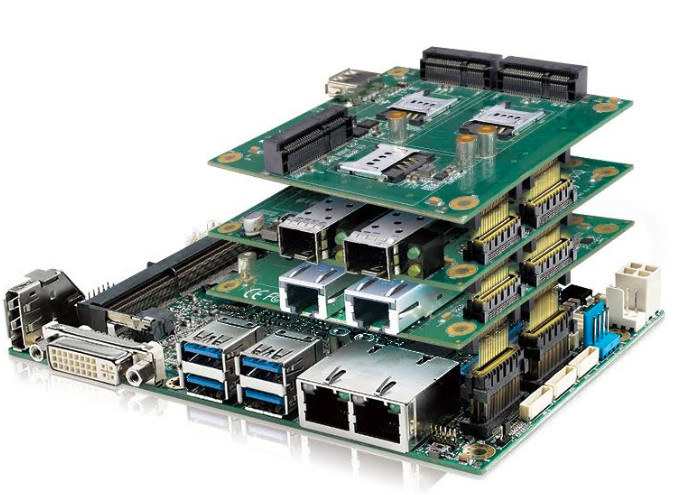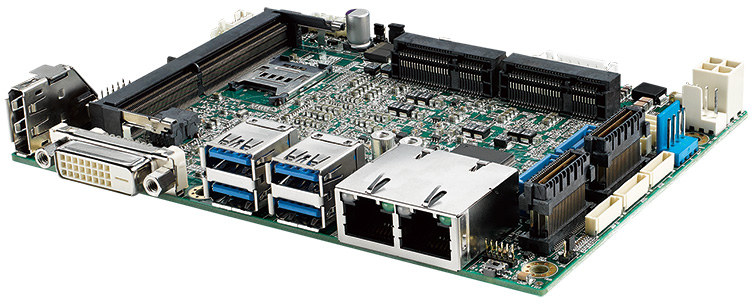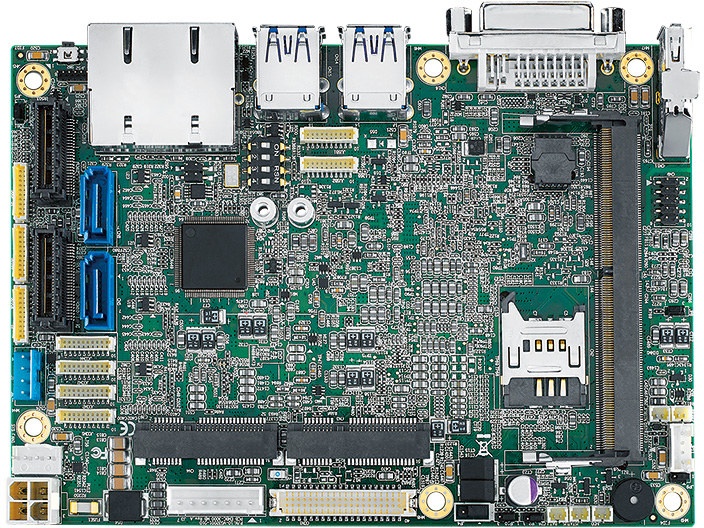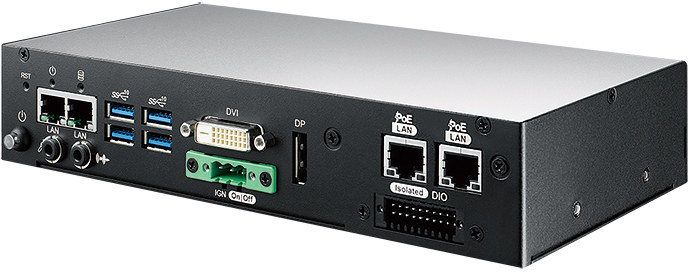Industrial AIoT
Vecow makes its latest entry into the industrial 4.0 and AIoT application market place with the announcement of the Whiskey Lake-UE based EMBC – 3000 3.5″ SBC and the SPC 5200 slim fanless computer system. The units are extremely similar, and it would seem the EMBC-3000 is inside the SPC-5200, so there are several options for the system features and setups. Whiskey Lake-UE processors, such as Core i7-8665UE, are the embedded, long-lifespan version of Whiskey Lake-U processors.
Company Background
Vecow has a long history in the embedded industrial computing industry, going back to 2011. Their latest embedded systems are a 3.5 form-factor SBC, the EMBC-3000 and the SPC-5200 slim build embedded computer, both built around the 8th Gen Whiskey Lake-UE processors with 15W TDPs. The EMBC-3000 are available with i-series or Celeron processors.
EMBC-3000 SBC Intended Uses and Application
The EMBC-3000 has been developed with machine vision and AGV (Automated Guided Vehicles) in mind, for use in factories, warehouses, distribution centers and other places where there is human and non-human interaction, like M2M, or M2H environments. The applications include factory-automation, intelligent control, and AVG/AGR. The uses span a wide range of industrial 4.0 and AIoT applications as well.
Specifications
 The units all support DDR4 2400MHz SO-DIMM up to 32 GB and a variety of I/O ports and connectors. There are four USB 3.1 Gen 2 ports with 10Gbps data transfer rates, four COM RS-232/422/485, sixteen isolated DIO, one SIM card socket, two Mini PCIe slot (8GT/s) and two SATA III (6G) ports. The units support triple displays, through Displayport, DVI-D and the dual-channel 24-Bit LVDS display interface and ports. Designed for a low profile form-factor, to fit inside a robot factory vehicle, with dimensions of 146mm x 102mm, EMBC-3000 offers full function SUMIT A, B expansion boards for 10GigE LAN, GigE LAN and PCIe slot for graphics cards, USB adaptor, and video card connectivity.
The units all support DDR4 2400MHz SO-DIMM up to 32 GB and a variety of I/O ports and connectors. There are four USB 3.1 Gen 2 ports with 10Gbps data transfer rates, four COM RS-232/422/485, sixteen isolated DIO, one SIM card socket, two Mini PCIe slot (8GT/s) and two SATA III (6G) ports. The units support triple displays, through Displayport, DVI-D and the dual-channel 24-Bit LVDS display interface and ports. Designed for a low profile form-factor, to fit inside a robot factory vehicle, with dimensions of 146mm x 102mm, EMBC-3000 offers full function SUMIT A, B expansion boards for 10GigE LAN, GigE LAN and PCIe slot for graphics cards, USB adaptor, and video card connectivity.

Specifications by Item
-
-
- Processor — Intel 8th Gen “Whiskey Lake” UE-series Core and Celeron (2x or 4x core @ up to 2.0GHz); Intel Gen 9.5 HD Graphics (24 EU); 15W TDP (configurable TDP of 12.5W to 25W)
- Memory — up to 32GB of 2400MHz DDR4 via dual sockets
- Storage:
- 2x SATA 3.0 with the power connector
- mSATA available via mini-PCIe (see farther below)
- Networking — 2x Gigabit Ethernet ports (Intel I210 and 1219LM with AMT 12.0) with WoL and PXE
- Display/media:
- DisplayPort up to 4096 x 2304 @ 60Hz
- LVDS (24-bit, dual-channel) at up to 1920 x 1200 with backlight connector
- DVI-D at up to 1920 x 1200 @ 60Hz
- Triple independent display support
- Mic-in, line-out interfaces (Realtek ALC892 HD audio)
- Other I/O:
- 4x USB 3.1 Gen 2 host ports at up to 10Gbps
- 2x USB 2.0
- 4x RS232/422/485
- GPIO, fan connector
- Expansion:
- 2x mini-PCIe (PCIe/USB) slots (1x with mSATA support, 1x with SIM card slot)
- Optional SUMIT A and B connectors on the i7-8665UE model for stackable 10GbE, GbE, PCIe/graphics, USB adaptor, or video cards
- Other features — Watchdog; HW monitoring; 2x LEDs; optional TPM, heatsink, heatspreader, cables
- Power — 9-48V DC; ATX connector; power and reset buttons; ignition control (16 Model)
- Operating temperatures — -40 to 85°C; 5% to 95% humidity, non-condensing
- Dimensions — 146 x 102mm (“3.5-inch form factor”)
- Operating system — Linux or Windows 10
-
The SPC-5200
The SPC 5200 is a slimline fanless computer system, meant to be used inside other devices or as a stand-alone industrial device. There is a slightly lower operating range for the SPC-5200 -40°C to 70° C. The dimensions are slightly bigger than the EMBC-3000 due to the enclosure, 246.1 x 53.8 x 44.0mm and there are shock absorption and vibration resistance, which are important during vehicle applications.
Additional Information
There is no pricing or ship date as of yet, for either the EMBC-3000 or the SPC-5200. You may find further details on the respective product pages. The information found in this article was provided in part by the Linuxgizmos article for the two hardware platforms.

Stephen started writing about technology after publishing sci-fi short stories. His first White-Paper, written in 2008, was well received and inspired him to continue writing about technology. Today he writes in the technology space full time, covering a multitude of topics. During the time he wrote part-time he edited hundreds of titles for large publishers, in science and technology. He lives in Staten Island, with his wife and children.
Support CNX Software! Donate via cryptocurrencies, become a Patron on Patreon, or purchase goods on Amazon or Aliexpress









Interesting that they are careful to never show the thermal cooling solution in any of the product shots or even the product page. Also interesting that it appears to mount upside-down in the assembled product photos.
It’s not surprising for products meant to be embedded into other ones, and only seen as basic components. It’s similar to when Intel or AMD presents a new CPU on stage, the guy just holds the CPU between his fingers, without the huge heat sink and fan that most often come with it.
I suspect we’re facing quite an expensive niche product here. Just seeing the amount of small-size or special connectors makes me think that the total cost of connectors is probably higher than the price of a full SBC at some competitors.
When I was looking for a mini-itx board with a V1605b I did fill the price inquiry form at a few of these industrial boards web sites. The average price was around $500. I would venture a guess of $1500 for the boxes. To my surprise they really did not care if you are an individual, they were ready to sell. Just have a corporate ID number ready for their purchase order paperwork. I used the one from a friend. I ended up buying a DFI for about $480 because I really wanted to try the V1605b.
Now I really would like to play with the AMD EPYC™ Embedded 3201! “Only” 30W, 8 cores, 10Gbe, USB3, SATA3, 32 lanes of PCIe Gen 3. An SBC with this thing would really kick some ass.
Not as powerful but a mini PC Chatreey S1-A320 is better value
@theguyuk
Good catch. I agree this Chatreey S1-A320 looks pretty good.
Maybe I should have mentioned my purpose: build a DIY NAS with multi-ten TB of storage in RAID10, serving at 10+ Gbe, with a power envelop close to 50W. The Chatreey and all these mini-PC boxes or boards built around a low desktop CPU or APU do not make the cut for such purpose.
My minimal requirements are at least 1 x PCIe 3 x8 slot, at least 4 x SATA 6Gbe, at least an M.2 M Key PCIe 3 x4 for boot/OS SSD, eMMC is an acceptable alternative, at least 1 x USB 3.1 Gen 2 for expansion, an M.2 B+M Key for a 802.11ax Wifi 6 card. Don’t care much about video but if no graphics from CPU then another 1 x PCIe 3 x8 slot. This “almost” implies embedded server CPUs which in general brings more PCIe lanes than their desktop cousins. I say “almost” because some low power desktop CPU + chipset may have just the minimal amount of PCIe lanes.
Again for desktop, HTPC or mild usage the S1-A320 with the 200ge has indeed a very good value.
True but the running and electric costs factor in too
Exactly. Personally I would be fine with under 50W for an always on NAS. The thing is that if you look at the prices practiced by QNAP, Sinology and the lesser known we are in the $1,500 / $2,000 (diskless) for that range of NAS. $1,500 / $2,000 is a huge amount in the SBC (non-industrial) world, so there would be a market for the DIY people like us.
Why is it that this site and one other (I forget the name of “Linux Something or another” constantly report on interesting SBC’s and other goodies but 80% of the time they list no price? It drives me nuts! Can they not ask or maybe fill out a form to get an estimated price? I can’t believe that so many vendors are keeping the price for their latest and greatest a friggin secret?
Not that I’ll be able to afford this but I’d be nice to know what existing products it’ll be priced around if nothing else.
The other site must be LinuxGizmos.
If a company reports the price we normally write about it, and for B2C board it will always be listed, but most B2B boards won’t have a public price. There should be several reasons for it. One may be because they don’t want competitors to see how much they charge, and the other is that most B2B projects have different requirements in terms of volume and customizations so there’s no fixed price.
Publishers can’t ask price because then it would be made public, and for whatever reasons most – although not all – embedded companies do not want to release those publicly. So readers need to contact them directly with their requirements to get a quote.
Yes Jean-Luc is 100% right and industrial boards is not a good solution for individuals like us: you pay the max (read crazy) price when buying one or two boards. In B2B deals the number of items is in the dozens, hundreds or thousands units and the unit price becomes much smaller. Note that the same thing happens in many other parts of this industry, the pricing of $11,000+ for a top of the top Intel Xeon Scalable Platinum is also for individual buying by the unit. Data centers or large organizations buying hundreds or thousands units will never pay this price. Same thing for racks, servers, disks, network cards and all other components.